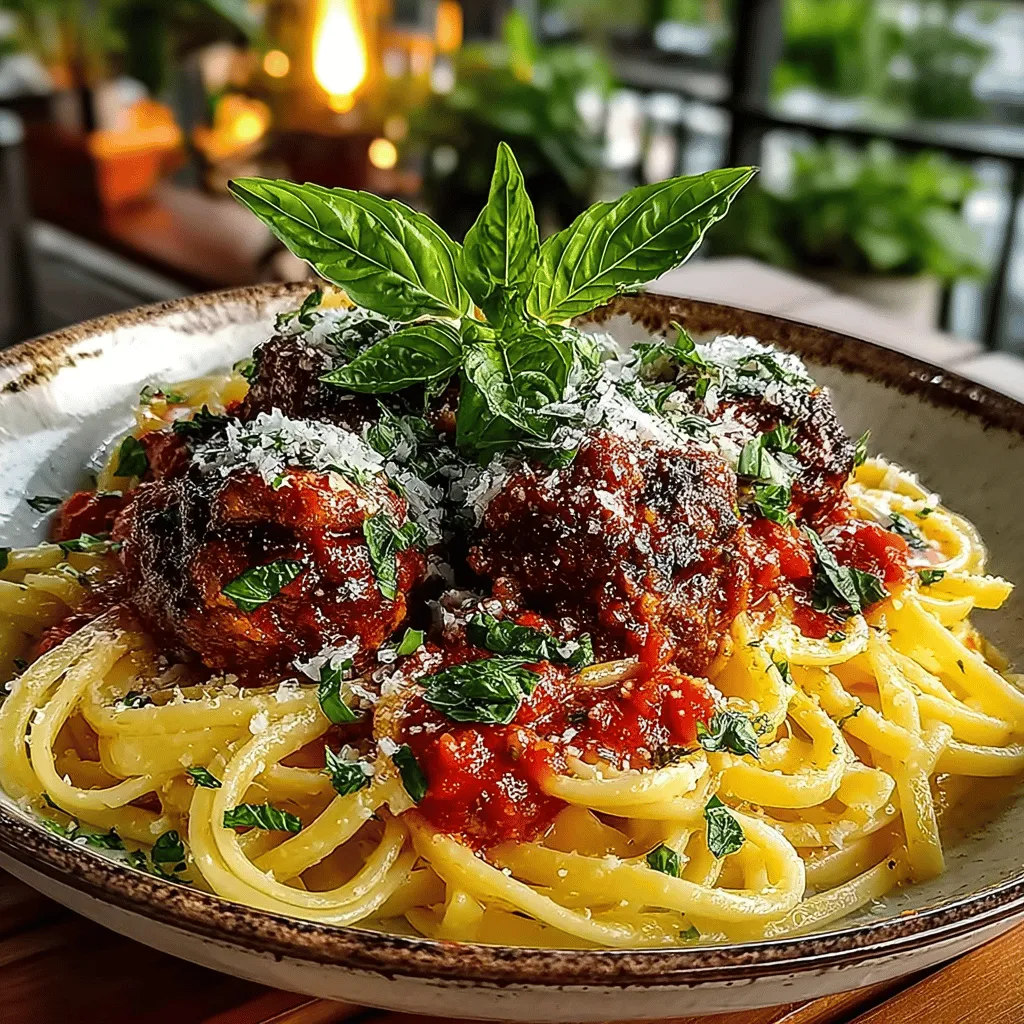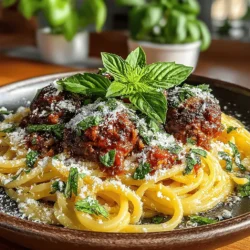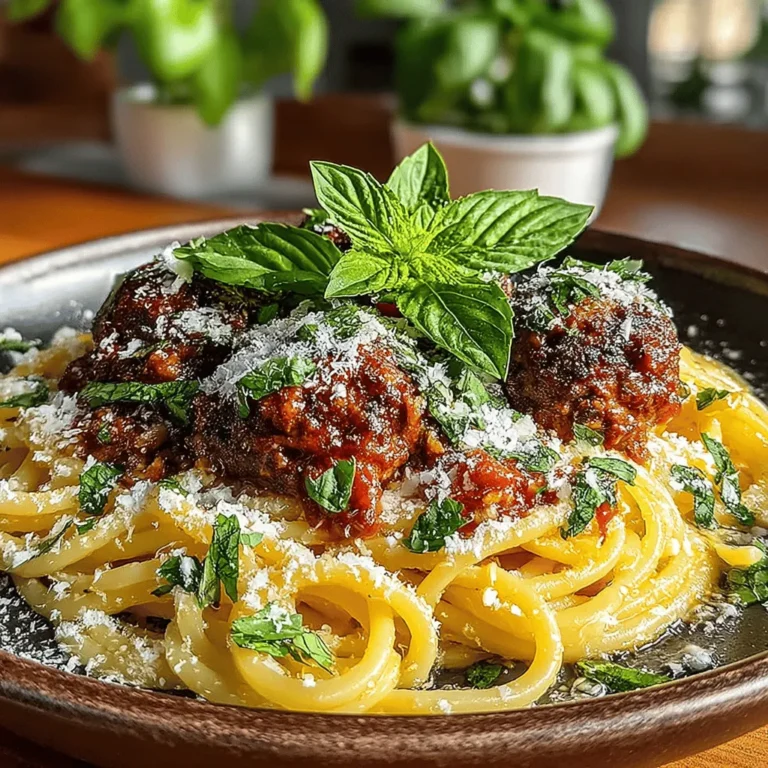Introduction to Classic Spaghetti & Meatballs
Classic spaghetti and meatballs is more than just a meal; it’s a cherished culinary tradition that resonates with many families across the globe. This dish has its roots in Italian cuisine but has evolved significantly within the context of Italian-American culture. Its combination of perfectly seasoned meatballs, simmered in a flavorful tomato sauce, and served over al dente spaghetti creates a symphony of tastes and textures that evoke feelings of comfort and nostalgia.
The origins of spaghetti and meatballs can be traced back to the late 19th and early 20th centuries when Italian immigrants brought their culinary traditions to the United States. While pasta was a staple in Italy, the combination with meatballs was a culinary innovation that emerged in America. Utilizing local ingredients and adapting to the available resources, immigrants created a dish that not only satisfied hunger but also fostered a sense of community and togetherness. Today, spaghetti and meatballs is a staple in countless households, often served during family gatherings, celebrations, or simply as a comforting weeknight dinner.
In this article, we will delve into the essential ingredients needed to create the perfect meatballs, the techniques required to craft them, and the secrets to making a rich tomato sauce that will elevate your dish. By the end, you’ll be equipped with the knowledge and skills to recreate this iconic Italian-American classic in your own kitchen, allowing you to share its warmth and flavor with your loved ones.
Understanding the Ingredients for Meatballs
The foundation of a great spaghetti and meatballs dish lies in the quality and selection of ingredients used to make the meatballs. Each component plays a crucial role in developing the flavor and texture of the final product. Here’s a closer look at the essential ingredients that will guide you in crafting the perfect meatballs.
Ground Beef: Choosing the Right Fat Content
The type of ground beef you select is vital to the overall taste and texture of your meatballs. A blend of ground beef with a fat content of around 80/20 is often recommended. This means that 80% of the mixture is lean meat, while 20% is fat. The fat not only adds flavor but also helps keep the meatballs moist during cooking. If you prefer a slightly healthier option, you can opt for ground turkey or chicken, although these leaner meats may require additional moisture to prevent dryness.
Breadcrumbs: The Role of Italian Seasoned Breadcrumbs
Breadcrumbs serve as a binding agent in meatballs, helping to maintain their shape while also contributing to their texture. Using Italian seasoned breadcrumbs adds an extra layer of flavor, as they often incorporate herbs and spices like oregano, basil, and garlic powder. Alternatively, you can make your own breadcrumbs using stale bread, which allows for greater control over the seasonings and freshness.
Parmesan Cheese: Adding Depth of Flavor
Parmesan cheese is another key ingredient that enhances the flavor profile of your meatballs. It adds a savory, umami element that complements the other ingredients beautifully. When selecting Parmesan cheese, opt for freshly grated or finely shredded varieties to achieve the best results. This will help the cheese melt evenly into the meat mixture, creating a cohesive flavor throughout.
Fresh Parsley: Enhancing Freshness and Color
Fresh parsley not only provides a pop of color to your meatballs but also contributes a fresh, herbaceous flavor. It’s important to use fresh herbs whenever possible, as they can significantly elevate the dish’s overall taste. Finely chopping the parsley ensures that its flavor is evenly distributed throughout the meatball mixture.
Garlic: Infusing Aromatic Flavor
Garlic is a foundational ingredient in many Italian recipes, and meatballs are no exception. Adding minced garlic to your meat mixture infuses the meatballs with a warm, aromatic flavor. Whether you choose to use fresh garlic or garlic powder is a matter of personal preference, but fresh garlic typically provides a more robust taste.
Eggs: Binding Ingredients Together
Eggs play a critical role in binding the ingredients of your meatballs together, ensuring they hold their shape during cooking. They add moisture and richness, contributing to the overall texture. Typically, one egg is sufficient for a pound of ground meat, but if you’re making a larger batch, you may need to adjust accordingly.
Seasoning: Balancing Salt and Pepper
The final touch in preparing your meatball mixture is seasoning. Salt and pepper are essential for enhancing the flavors of all the other ingredients. It’s crucial to season your mixture generously, as ground meat tends to absorb flavors during cooking. Tasting a small portion of the raw mixture before cooking can help you determine if you need to adjust the seasoning.
Crafting the Perfect Meatballs
With a clear understanding of the ingredients, it’s time to put that knowledge into action and craft the perfect meatballs. This process involves several key steps that will ensure your meatballs are flavorful, tender, and well-formed.
Preheating the Oven: Setting the Stage for Cooking
Before you begin mixing your ingredients, it’s essential to preheat your oven to 400°F (200°C). This ensures that the meatballs cook evenly, developing a nice golden-brown crust while remaining juicy on the inside. A hot oven is crucial for achieving that desirable texture.
Mixing the Ingredients: Achieving the Right Consistency
In a large mixing bowl, combine your ground beef, breadcrumbs, grated Parmesan cheese, chopped parsley, minced garlic, egg, salt, and pepper. Using your hands or a fork, gently mix the ingredients until they are just combined. Take care not to overmix, as this can lead to tougher meatballs. The goal is to achieve a uniform mixture where all the ingredients are evenly distributed.
Forming Meatballs: Techniques for Size and Shape
Once your mixture is ready, it’s time to form your meatballs. Using a cookie scoop or your hands, take a portion of the mixture and roll it into a ball, approximately 1 to 1.5 inches in diameter. This size is ideal for even cooking and easy serving over spaghetti. Place the formed meatballs on a baking sheet lined with parchment paper, leaving space between each ball to ensure they cook evenly.
Baking: Ensuring Even Cooking and Browning
After shaping your meatballs, bake them in the preheated oven for about 20-25 minutes, or until they are cooked through and nicely browned on the outside. Baking rather than frying allows for a healthier option while still achieving deliciously caramelized meatballs. If you prefer an extra layer of flavor, you can finish the meatballs in a skillet with a bit of olive oil for a minute or two after baking.
The next step in creating your classic spaghetti and meatballs involves crafting the rich tomato sauce, which will serve as the perfect complement to your freshly baked meatballs. Stay tuned for insights on how to build a flavorful sauce that elevates this dish to new heights.

Sugar: Balancing Acidity in the Sauce
One of the essential aspects of creating a delicious spaghetti sauce is balancing its acidity. Tomatoes, while rich in flavor, can often lead to a sauce that is overly acidic. This is where sugar comes into play. Adding a small amount of sugar, typically one to two teaspoons, can help round out the flavors of your sauce and cut through the acidity, creating a more harmonious and pleasant taste.
When incorporating sugar, it’s crucial to add it gradually. Start with a teaspoon, stir it in, and taste the sauce before adding more. The goal is to enhance the natural sweetness of the tomatoes without making the sauce taste overtly sweet. This subtle balance will elevate your spaghetti sauce, ensuring that it complements the meatballs and pasta beautifully.
Cooking the Spaghetti to Perfection
Choosing the Right Pasta for Spaghetti and Meatballs
When it comes to spaghetti, the options can be overwhelming. However, for a classic spaghetti and meatballs dish, traditional long strands of pasta are your best bet. Look for high-quality spaghetti made from durum wheat semolina, which gives it a firm texture and helps it hold up to the hearty meatballs and rich sauce.
You may also consider using different types of pasta, such as whole wheat spaghetti for a healthier option or gluten-free spaghetti if dietary restrictions are a concern. The choice should reflect your personal preference while still bringing out the best flavors of your dish.
Types of Spaghetti: Understanding Different Varieties
Different varieties of spaghetti can bring unique textures and flavors to your dish. Here are a few to consider:
– Spaghetti: The classic choice, usually around 10-12 inches long, has a round shape and is perfect for holding onto sauce.
– Spaghettini: Thinner than traditional spaghetti, it cooks faster and is great for lighter sauces.
– Bucatini: This spaghetti variant has a hollow center, allowing it to absorb sauces well.
– Capellini: Also known as angel hair pasta, it is very thin and cooks quickly, making it suitable for delicate sauces.
Choosing the right pasta can enhance the overall experience of your spaghetti and meatballs dish, so consider your preferences and cooking time when making your selection.
Cooking Techniques: Achieving Al Dente Texture
To achieve the perfect texture for your spaghetti, cooking it al dente, or “to the tooth,” is essential. This means that the pasta should be tender but still have a slight bite to it. Here’s how to do it:
1. Boil Water: Use a large pot with plenty of water. For every pound of pasta, use at least four quarts of water.
2. Salt the Water: Before adding the pasta, generously salt the boiling water. This is your opportunity to flavor the pasta itself, enhancing the overall dish.
3. Add the Pasta: Once the water is at a rolling boil, add the spaghetti. Stir occasionally to prevent sticking.
4. Cook According to Package Instructions: Refer to the package for the recommended cooking time, typically around 8-12 minutes for spaghetti.
5. Taste Test: About a minute before the recommended cooking time, taste a strand. It should be cooked through but firm in the center.
6. Drain and Rinse: Once cooked, drain the pasta in a colander. Avoid rinsing unless you’re preparing a cold pasta salad, as the starch helps the sauce cling to the pasta.
Importance of Salting the Water: Enhancing Flavor
Salting the pasta water is a crucial step often overlooked by novice cooks. The water should taste like the sea when the pasta is added. This simple step enhances the flavor of the pasta itself, which is vital when it will be served with a robust sauce like spaghetti and meatballs. Salt not only flavors the pasta but also helps it cook evenly, bringing out its best qualities. Ensure you add the salt after the water has reached a boil for maximum effectiveness.
Combining Elements for a Harmonious Dish
Bringing Together Meatballs, Sauce, and Spaghetti
The magic of spaghetti and meatballs lies in the combination of its components. Once your meatballs are cooked and your sauce is simmering, it’s time to bring everything together.
1. Simmering Meatballs in Sauce: After browning your meatballs, add them directly to the sauce and allow them to simmer together for at least 20-30 minutes. This process infuses the meatballs with the rich flavors of the sauce, ensuring that they are moist and flavorful.
2. Combining with Spaghetti: Once your meatballs have simmered in the sauce, you can either serve them directly on top of the spaghetti or mix them together in the pot. If you choose to mix, add the drained spaghetti to the sauce and meatballs, tossing gently to coat the pasta evenly.
Plating Techniques: Presenting the Dish Beautifully
Presentation is key when serving spaghetti and meatballs. Here are some tips for plating:
– Use a Large Serving Bowl: A wide bowl allows you to create a beautiful nest of spaghetti topped with meatballs and sauce.
– Twirl the Spaghetti: Use a fork or a pasta server to twirl the spaghetti into a nest shape in the center of the bowl.
– Layering: Start with spaghetti, then add a generous ladle of sauce, and top with 2-3 meatballs for a visually appealing dish.
– Sauce Drizzle: Drizzle additional sauce around the edges of the plate to create an inviting presentation.
Garnishing: Adding Freshness with Basil and Parmesan
Finally, no spaghetti and meatballs dish is complete without the right garnishes. Freshly grated Parmesan cheese adds a savory touch, while a sprinkle of chopped fresh basil or parsley brings a pop of color and freshness.
1. Parmesan: Use a microplane or a fine grater to freshly grate Parmesan cheese over the top of your dish. This adds a creamy, nutty flavor that complements the sauce and meatballs.
2. Herbs: Fresh herbs, such as basil or parsley, not only enhance the visual appeal but also add a fresh, aromatic note. Scatter them over the finished dish just before serving for the best impact.
Nutritional Insights of Spaghetti & Meatballs
Analyzing the Nutritional Benefits of the Dish
Classic spaghetti and meatballs can be a fulfilling meal that provides various nutrients, making it a favorite for many. Here’s a breakdown of its nutritional benefits:
Protein Content from Meatballs
Meatballs are typically made from ground beef, pork, or turkey, providing a significant source of protein. Protein is essential for muscle repair, growth, and overall body function. Using lean ground meat can help keep the dish healthy while still offering the satisfying protein boost that meatballs provide.
Carbohydrates from Spaghetti
Spaghetti serves as a great source of carbohydrates, which are vital for providing energy. Whole grain or whole wheat spaghetti options can add fiber to the dish, promoting digestive health and helping to keep you full longer.
Vitamins and Minerals from Fresh Ingredients
The tomato sauce in spaghetti and meatballs is rich in vitamins A and C, along with antioxidants like lycopene, which may have several health benefits. Additionally, fresh herbs like basil not only enhance flavor but also provide essential vitamins and minerals, contributing to a balanced meal.
Cultural Significance of Spaghetti & Meatballs
Exploring the History of this Iconic Dish
Spaghetti and meatballs is not just a dish; it’s a cultural icon with a rich history. Originating in Italy, the combination of pasta and meat was not traditionally served together. Instead, meatballs were often enjoyed separately, but as Italian immigrants made their way to America, they adapted their culinary practices to fit their new environment.
Origins in Italy: Traditional vs. American Adaptations
In the traditional Italian kitchen, pasta was often served as a first course (primo) with a light sauce, followed by meat as a second course (secondo). The American adaptation of combining spaghetti with meatballs in a hearty tomato sauce emerged in the late 19th and early 20th centuries and quickly gained popularity. This dish has become a staple in Italian-American cuisine, symbolizing the blending of cultures and culinary practices.
Spaghetti & Meatballs in Popular Culture
Spaghetti and meatballs have found their way into popular culture as well. From classic cartoons featuring characters slurping up long strands of spaghetti to films and television shows depicting family gatherings centered around this dish, it has become synonymous with comfort and togetherness.
The Dish as a Symbol of Family and Togetherness
Ultimately, spaghetti and meatballs represent more than just a meal; they embody family traditions, gatherings, and shared experiences around the table. This dish is often served during special occasions and family dinners, making it a beloved symbol of unity and love among families.
Conclusion: Enjoying the Timelessness of Spaghetti & Meatballs
In conclusion, classic spaghetti and meatballs is more than just a meal; it’s a celebration of tradition, flavor, and the joy of sharing. With this recipe and understanding of its components, you can create a dish that not only satisfies the palate but also warms the soul. Whether enjoyed on a casual weeknight or a festive gathering, this timeless classic is sure to bring smiles to the table.
Prepare your ingredients, follow the steps carefully, and savor the rich history and flavors of this cherished dish. As you gather your loved ones around the table, remember that each bite tells a story of heritage, love, and the joy of togetherness. Enjoy your homemade spaghetti and meatballs, and embrace the timelessness of this iconic culinary delight.


